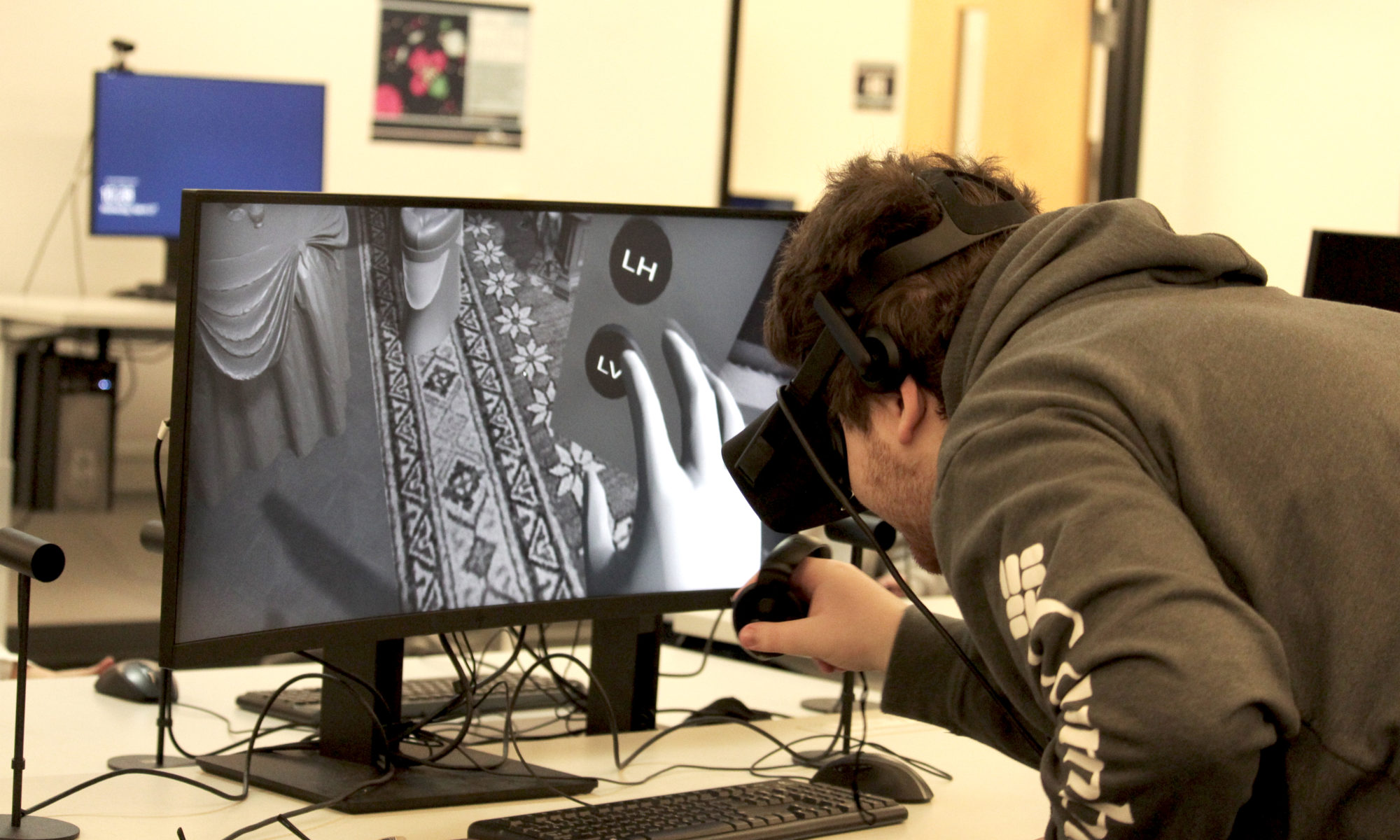Behind the Scenes: Re-creating Citizen Kane in VR
inside a classic
Stephanie O’Malley
Students in Matthew Solomon’s classes are used to critically analyzing film. Now they get the chance to be the director for arguably one of the most influential films ever produced: Citizen Kane.

Using an application developed at the Duderstadt Center with grant funding provided by LSA Technology Services, students are placed in the role of the film’s director and able to record a prominent scene from the movie using a virtual camera. The film set which no longer exists, has been meticulously re-created in black and white CGI using reference photographs from the original set, with a CGI Orson Welles acting out the scene on repeat – his actions performed by Motion Capture actor Matthew Henerson, carefully chosen for his likeness to Orson Welles, with the Orson avatar generated from a photogrammetry scan of Matthew.

Analyzing the original film footage, doorways were measured, actor heights compared, and footsteps were counted, to determine a best estimate for the scale of the set when 3D modeling. With feedback from Citizen Kane expert, Harlan Lebo, fine details down to the topics of the books on the bookshelves were able to be determined.

Motion Capture actor Matthew Henerson was flown in to play the role of the digital Orson Welles. In a carefully choreographed session directed by Matthew’s PhD student, Vincent Longo, the iconic scene from Citizen Kane was re-enacted while the original footage played on an 80″ TV in the background, ensuring every step aligned to the original footage perfectly.

The boundaries of the set were taped on the floor so the data could be aligned to the digitally re-created set. Eight Vicon motion capture cameras, the same used throughout Hollywood for films like Lord of the Rings or Planet of the Apes, formed a circle around the makeshift set. These cameras rely on infrared light reflected off of tiny balls affixed to the motion capture suit to track the actor’s motion. Any props during the motion capture recording were carefully constructed out of cardboard and PVC (later to be 3D modeled) so as to not obstruct his movements. The 3 minutes of footage attempting to be re-created took 3 days to complete, comprised over 100 individual mocap takes and several hours of footage, which were then compared for accuracy and stitched together to complete the full route Orson travels through the environment.


Matthew Henerson then swapped his motion capture suit for an actual suit, similar to that worn by Orson in the film, and underwent 3D scanning using the Duderstadt Center’s photogrammetry resources.

Photogrammetry is a method of scanning existing objects or people, commonly used in Hollywood and throughout the video game industry to create a CGI likenesses of famous actors. This technology has been used in films like Star Wars (an actress similar in appearance to Carrie Fischer was scanned and then further sculpted, to create a more youthful Princess Leia) with entire studios now devoted to photogrammetry scanning. The process relies on several digital cameras surrounding the subject and taking simultaneous photographs.

The photos are submitted to a software that analyzes them on a per-pixel basis, looking for similar features across multiple photos. When a feature is recognized, it is triangulated using the focal length of the camera and it’s position relative to other identified features, allowing millions of tracking points to be generated. From this an accurate 3D model can be produced, with the original digital photos mapped to its surface to preserve photo-realistic color. These models can be further manipulated: Sometimes they are sculpted by an artist, or, with the addition of a digital “skeleton”, they can be driven by motion data to become a fully articulated digital character.
The 3d modeled scene and scanned actor model were joined with mocap data and brought into the Unity game engine to develop the functionality students would need to film within the 3D set. A virtual camera was developed with all of the same settings you would find on a film camera from that era. When viewed in a virtual reality headset like the Oculus Rift, Matthew’s students can pick up the camera and physically move around to position it at different locations in the CGI environment, often capturing shots that otherwise would be difficult to do in a conventional film set. The footage students film within the app can be exported as MP4 video and then edited in their editing software of choice, just like any other camera footage.

Having utilized the application for his course in the Winter of 2020, Matthew Solomon’s project with the Duderstadt Center was recently on display as part of the iLRN’s 2020 Immersive Learning Project Showcase & Competition. With Covid-19 making the conference a remote experience, the Citizen Kane project was able to be experienced in Virtual Reality by conference attendees using the FrameVR platform. Highlighting innovative ways of teaching with VR technologies, attendees from around the world were able to learn about the project and watch student edits made using the application.






 Another project related to remote performances involved a faculty member from the school of music who specialized in jazz compositions. He conducted a collection of performers remotely using methods similar to the dancers above. One unique challenge was the expressiveness and articulation of the composers hands and face. To solve this we placed additional markers on his face and hands so the remote musicians could identify his facial expressions and hand poses.
Another project related to remote performances involved a faculty member from the school of music who specialized in jazz compositions. He conducted a collection of performers remotely using methods similar to the dancers above. One unique challenge was the expressiveness and articulation of the composers hands and face. To solve this we placed additional markers on his face and hands so the remote musicians could identify his facial expressions and hand poses.